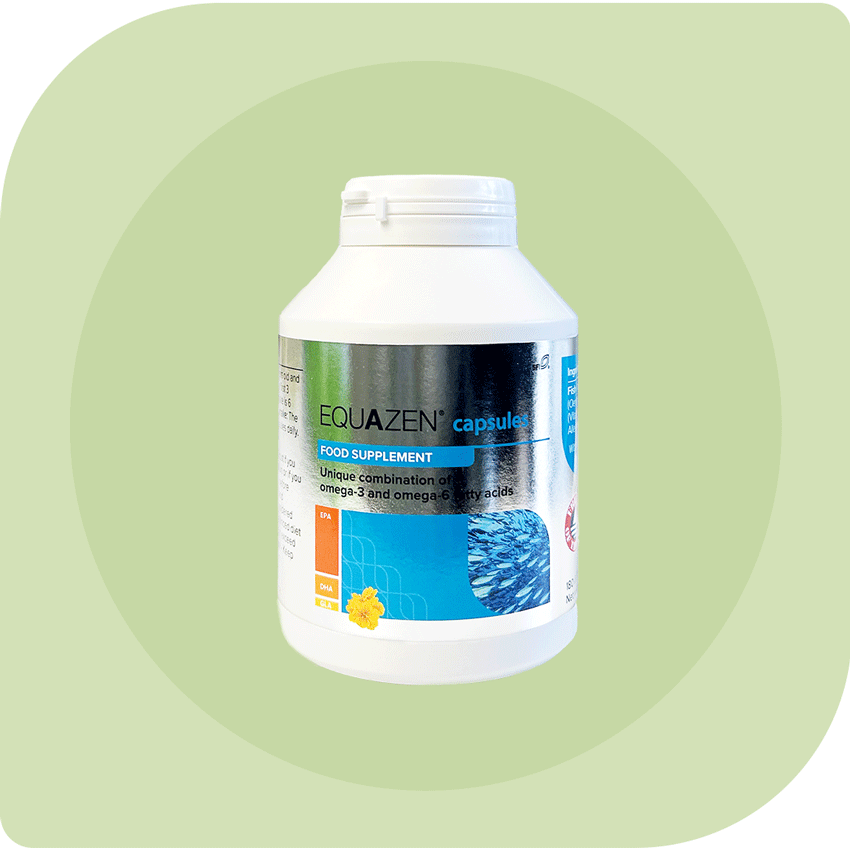This site is protected by hCaptcha and the hCaptcha Privacy Policy and Terms of Service apply.
Don't forget these...
Features & Benefits
Equazen Capsules (Previously Eye Q) - Naturally sourced Omega 3 & Omega 6.
A Unique Formulation:
Equazen (Previously Eye Q) is a scientifically developed unique formulation of high EPA Omega 3 and Omega 6. Its specific combination of Omega 3 EPA and DHA together with Omega 6 GLA ensures a synergistic and balanced formulation.
Your body cannot produce Omega 3 so it must come from the diet, with oily fish being a great source.
EPA & DHA are Omega 3 Essential Fatty Acids whilst GLA is categorised as an Omega 6 Essential Fatty Acid (they are called “essential” because they are literally essential to our health and must be consumed in the diet because our bodies are unable to manufacture them). It appears that the ratio between Omega 3 & Omega 6 intake is an important factor in influencing cancer incidence and progression.
Equazen is an easy and convenient way to get a balanced intake of Omega 3 and Omega 6. Only high quality natural ingredients are used to produce Equazen.
Essential fatty acids such as Omega 3 and Omega 6 are vital for good health. They play a key role in almost every part of your body.
Ingredients
Equazen (previously EyeQ) oil comes from sustainable sources of oily fish, such as sardines, renowned for their naturally high level of EPA. Following a special purification process, Equazen oils have been developed with special care and are of the highest purity, independent testing ensures each batch is in full compliance with stringent EC and WHO rules on environmental pollutants.
How to use
Starting Dose: (First 3 Months) 6 capsules per day
Maintenance Dose : 2 capsules per day
Equazen Products Contain No:Casein, Gluten, Aspartame, Saccharine, Artificial flavours, Artificial colours
FAQ's
Here you can place an explanation or answer to the question.
Published Research
Published Research; Essential Fatty Acids
1). The Oxford Durham Study: A Randomized, Controlled Trial of Dietary Supplementation with Fatty Acids in Children with Developmental Co-ordination Disorder. Pediatrics, 115, 1360-1366
2). Effect of supplementation with polyunsaturated fatty acids and micronutrients on Learning and Behaviour problems Associated with Child ADHD. Sinn, N. & Bryan, J. (2007 Journal of Developmental & Behavioral Pediatrics, 28, 82 – 91
3). The role of dietary fatty acids on children’s behaviour and learning Portwood, M. (2006). Journal of Nutrition and Health, 18, 219–232
4). Assessing the effects of omega-3 and -6 fatty acids in features of autistic spectrum disorder The Sunderland Autism Study.
5). MRI Work on Chronic Fatigue Syndrome The International Journal of Clinical Practice, PLEFA and Acta Psychiatry Scandanivia.
6). Omega-3/Omega-6 Fatty Acids for Attention Deficit Hyperactivity Disorder: A Randomized Placebo-Controlled Trial in Children and Adolescents J Atten. Disord. 2009; 12(5):394–401.
7). Efficacy and safety of omega-3/6 fatty acid supplementation alone or in combination with methylphenidate in pediatric patients with ADHD. CADDRA Conference 2011, 14.–16. 10. 2011, Toronto. Barragán Pérez EJ,
8). Effects of fish oil supplementation on learning and behaviour of children from Australian Indigenous remote community schools: A randomised controlled trial$ Prostaglandins Leukotrienes Essent. Fatty Acids (2013), http://dx.doi.org/10.1016/j.plefa.2013.05.001i
9). Augmentation of antidepressants with unsaturated fatty acids omega-3 in drug-resistant depression Psychiatria Polska 2012, tom XLVI, numer 4 strony 585–598
10). Effectiveness of the Use of an Omega 3 and Omega 6 Combination (Equazen™) in Paediatric Patients with Refractory Epilepsy J Epilepsy Clin Neurophysiol 2011;
11). High Physiological Omega-3 Fatty Acid Supplementation AffectsMuscle Fatty Acid Composition and Glucose and Insulin Homeostasis in Obese Adolescents Sweden Journal of Nutrition and Metabolism Volume 2012, Article ID 395757,
12). Fatty acids in ADHD: plasma profiles in a placebo-controlled study of Omega 3/6 fatty acids in children and adolescents. ADHD Atten Def Hyp Disord DOI



